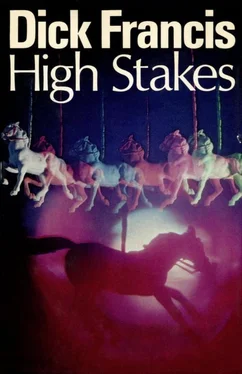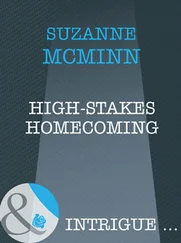‘A bachelor’s pad if ever I saw one,’ Allie said, looking around her. ‘Not a frill in sight.’ She walked across and looked out through the sliding glass wall to the balcony. ‘Don’t you just hate all that traffic?’
Cars drove incessantly along the road below, yellow sidelights shining through the glistening rain.
‘I quite like it,’ I said. ‘In the summer I practically live out there on the balcony... breathing in great lungfuls of exhaust fumes and waiting for the clouds to roll away.’
She laughed, unbuttoned her mac and took it off. The red dress underneath looked as unruffled as it had at lunch. She was the one splash of bright colour in that room of creams and browns, and she was feminine enough to know it.
‘Drink?’ I suggested.
‘It’s a bit early...’ She looked around her as if she had expected to see more than sofas and chairs. ‘Don’t you keep any of your toys here?’
‘In the workshop,’ I said. ‘Downstairs.’
‘I’d love to see them.’
‘All right.’
We went down to the hall again and turned towards the back of the house. I opened the civilised wood-panelled door which led straight from carpet to concrete, from white collar to blue, from champagne to tea breaks. The familiar smell of oil and machinery waited there in the dark. I switched on the stark bright lights and stood aside for her to go through.
‘But it is ... a factory.’ She sounded astonished.
‘What did you expect?’
‘Oh, I don’t know. Something much smaller, I guess.’
The workshop was fifty feet long and was the reason I had bought the house on my twenty-third birthday with money I had earned myself. Selling off the three top floors had given me enough back to construct my own first floor flat, but the heart of the matter lay here, legacy of an old-fashioned light engineering firm that had gone bust.
The pulley system that drove nearly the whole works from one engine was the original, even if now powered by electricity instead of steam, and although I had replaced one or two and added another, the old machines still worked well.
‘Explain it to me,’ Allie said.
‘Well... this electric engine here...’ I showed her its compact floor-mounted shape. ‘... drives that endless belt, which goes up there round that big wheel.’
‘Yes.’ She looked up where I pointed.
‘The wheel is fixed to that long shaft which stretches right down the workshop, near the ceiling. When it rotates, it drives all those other endless belts going down to the machines. Look, I’ll show you.’
I switched on the electric motor and immediately the big belt from it turned the wheel, which rotated the shaft, which set the other belts circling from the shaft down to the machines. The only noises were the hum of the engines, the gentle whine of the spinning shaft and the soft slapping of the belts.
‘It looks alive,’ Allie said. ‘How do you make the machines work?’
‘Engage a sort of gear inside the belt, then the belt revolves the spindle of the machine.’
‘Like a sewing machine,’ Allie said.
‘More or less.’
We walked down the row. She wanted to know what job each did, and I told her.
‘That’s a milling machine, for flat surfaces. That’s a speed lathe; I use that for wood as well as metal. That tiny lathe came from a watchmaker for ultra fine work. That’s a press. That’s a polisher. That’s a hacksaw. And that’s a drilling machine; it bores holes downwards.’
I turned round and pointed to the other side of the workshop.
‘That big one on its own is an engine lathe, for heavier jobs. It has its own electric power.’
‘It’s incredible. All this.’
‘Just for toys?’
‘Well...’
‘These machines are all basically simple. They just save a lot of time.’
‘Do toys have to be so... well... accurate? ’
‘I mostly make the prototypes in metal and wood. Quite often they reach the shops in plastic, but unless the engineering’s right in the first place the toys don’t work very well, and break easily.’
‘Where do you keep them?’ She looked around at the bare well-swept area with no work in sight.
‘Over there. In the right-hand cupboard.’
I went over with her and opened the big double doors. She pulled them wider with outstretched arms.
‘Oh!’ She looked utterly astounded.
She stood in front of the shelves with her mouth open and her eyes staring, just like a child.
‘Oh,’ she said again, as if she could get no breath to say anything else. ‘Oh... They’re the Rola toys!’
‘Yes, that’s right.’
‘Why didn’t you say so?’
‘Habit, really. I never do.’
She gave me a smile without turning her eyes away from the bright coloured rows in the cupboard. ‘Do so many people ask for free samples?’
‘It’s just that I get tired of talking about them.’
‘But I played with them myself.’ She switched her gaze abruptly in my direction, looking puzzled. ‘I had a lot of them in the States ten or twelve years ago.’ Her voice plainly implied that I was too young to have made those.
‘I was only fifteen when I did the first one,’ I explained. ‘I had an uncle who had a workshop in his garage... he was a welder, himself. He’d shown me how to use tools from the time I was six. He was pretty shrewd. He made me take out patents before I showed my idea to anyone, and he raised and lent me the money to pay for them.’
‘Pay?’
‘Patents are expensive and you have to take out one for each different country, if you don’t want your idea pinched. Japan, I may say, costs the most.’
‘Good heavens.’ She turned back to the cupboard, put out her hand and lifted out the foundation of all my fortunes, the merry-go-round.
‘I had the carousel,’ she said. ‘Just like this, but different colours.’ She twirled the centre spindle between finger and thumb so that the platform revolved and the little horses rose and fell on their poles. ‘I simply can’t believe it.’
She put the merry-go-round back in its slot and one by one lifted out several of the others, exclaiming over old friends and investigating the strangers. ‘Do you have a Rola-base down here?’
‘Sure,’ I said, lifting it from the bottom of the cupboard.
‘Oh do let me... please?’ She was as excited as if she’d still been little. I carried the base over to the workbench and laid it there, and she came over with four of the toys.
The Rola-base consisted of a large flat box, in this case two feet square by six inches deep, though several other sizes had been made. From one side protruded a handle for winding, and one had to have that side of the Rola-base aligned with the edge of the table, so that winding was possible. Inside the box were the rollers which gave the toy its phonetic Rola name; wide rollers carrying a long flat continuous belt inset with many rows of sideway facing cogwheel teeth. In the top of the box were corresponding rows of holes: dozens of holes altogether. Each of the separate mechanical toys, like the merry-go-round and a hundred others, had a central spindle which protruded down from beneath the toy and was grooved like a cogwheel. When one slipped any spindle through any hole it engaged on the belt of cog teeth below, and when one turned the single handle in the Rola-base, the wide belt of cog teeth moved endlessly round and all the spindles rotated and all the toys performed their separate tasks. A simple locking device on the base of each toy engaged with stops by each hole to prevent the toy rotating as a whole.
Allie had brought the carousel and the roller-coaster from the fairground set, and a cow from the farm set, and the firing tank from the army set. She slotted the spindles through random holes and turned the handle. The merry-go-round went round and round, the trucks went up and down the roller-coaster, the cow nodded its head and swished its tail, and the tank rotated with sparks coming out of its gun barrel.
Читать дальше












